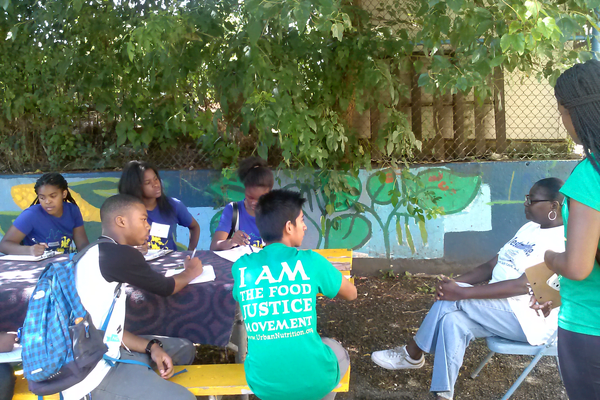by Kirtrina Baxter | 04/03/2014
When I first moved back to Philadelphia in 2012, I was excited to see first-hand what was happening in the food justice movement. I had researched some of the wonderful youth programming that was happening around gardens, growing food, nutrition education and entrepreneurism. These programs mirrored projects around the country that are attacking the issue of food insecurity and access, urban land reform, sustainability, self advocacy and self-determination for low-income populations and marginalized peoples.
One of the first events I attended was a conference with a “food justice” theme. The keynote speaker at this event was Malik Yakini from D-town Farms, in Detroit Michigan. During his talk he pointed out that although the population of city was made up of a majority of people of color, the folks in the room did not mirror this statistic. He stated his now famous quote that white “allies” in this movement should be “working themselves out of a job”, if they truly understood what this movement was about. In my naivety, I was not prepared for the reality of what “food justice” looked like in Philadelphia.
I was moving back here from a place where the percentage of people of color was less than 15%. The city officials mirrored this and had just voted in their youngest and first black mayor. The food justice movement there was burgeoning, though most of the players, like here, were white. An interesting difference was, though they were the majority, they understood that it made sense to engage leaders of color in the movement even if that meant creating access to education and skills building for people of color to take on these leadership roles. (Though not always without a fight or as timely as we would have liked) Even with all the advocacy that had to be done to make these steps possible, the lack of people interested in these positions was a problem to making them a reality.
Philadelphia, having a long history of advocacy and social justice movements as well as urban gardening, should have been right up there with Detroit and Oakland when it came to engaging leaders of color in this food movement. When I moved back here I was excited about all the young people of color I was meeting who knew all about nutrition, lived healthier lifestyles, and were interested in food choices and gardening. For that matter, I know from long ago, that W. Philly has a long standing black population of vegans and vegetarians who are older and more established. I remember seeing them at cultural events where they would be vending with information about nutrition or providing nourishing meals. They are still present at these events today, joined by this new wave of young people who are just as excited and eager to learn and share their knowledge around these issues. Why they are not employed within the organizations that have dedicated themselves to these ideals is beyond me?
Embracing cultural differences is a strong tonic, along a lot of lines. Understanding that our differences are not a cause to feel threatened seems a tall order in our country, though it is extremely important if we are to create social change that benefits all. Another interesting fact I like to point out when talking about diversity in the food justice movement is that, those of us who understand how important bio-diversity is to agriculture, should be able to grasp the importance of diversity in social movements.
So why does the food justice movement here in Philadelphia look like it does? Where is the diversity? Why doesn’t the movement reflect the people of the city in which we live? There are various reasons for this and I will mention a few that come to mind: lack of access to resources for social justice groups created by people of color, priority- in established social change organizations, lack of information sharing across organizations, unacknowledgment of white privilege in non-profit and progressive social change organizations and/or lack of tools to effectively address this issue, lack of shared spaces/events that comfortably engage a diverse population and nepotism.
What food justice looks like here in Philadelphia is not a phenomena, it is actually the norm across the country. There are some exceptions, including a few mentioned above, though this is a dilemma we face in creating real social change through this movement. The question begs to be answered, what are we prepared to do about this?
Pearl Conestoga Community Garden


